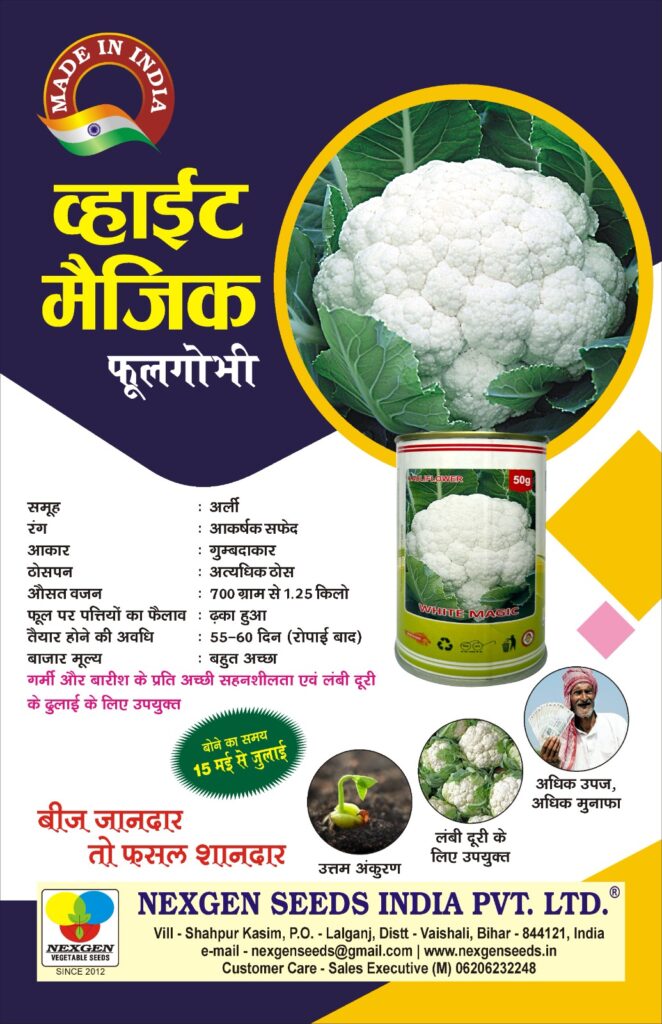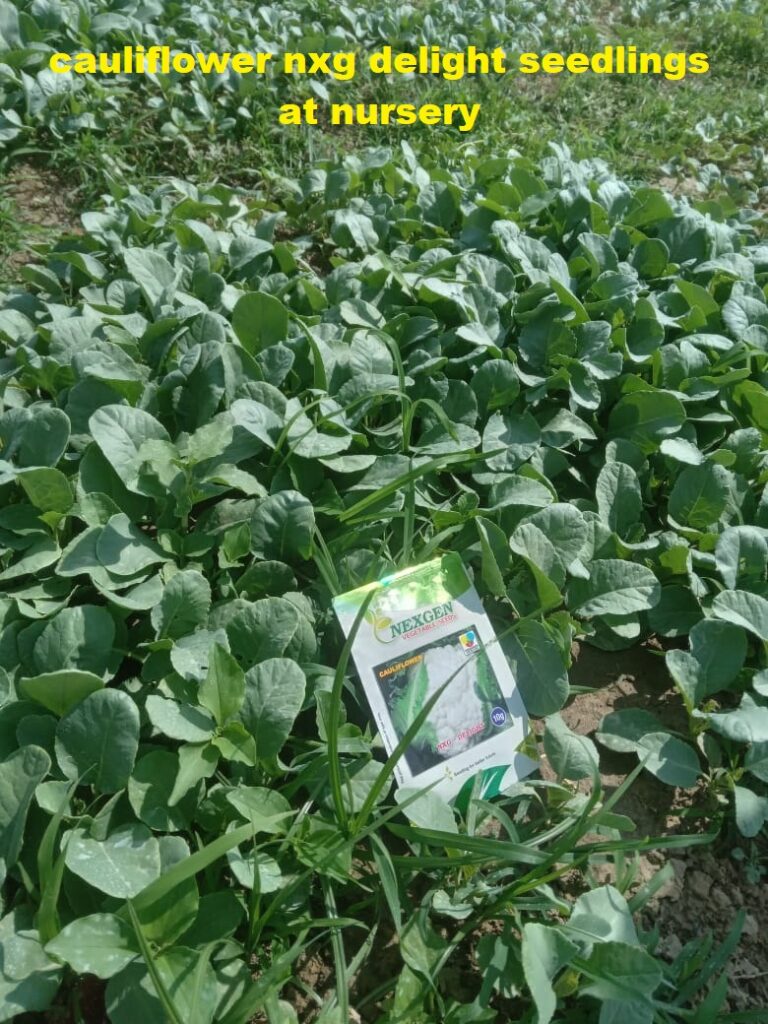Introduction:
Cauliflower is a versatile and nutritious vegetable that can be grown in various environments, including containers. With the advent of the Nxg series of cauliflowers, such as NXG Delight, NXG White Lady, NXG Tejas, NXG Karishma, NXG Anmol, NXG 172, NXG 911, NXG White Magic, NXG 1033, and NXG Hansa, cultivating this vegetable has become even more exciting. In this blog post, we will delve into the comprehensive approach to growing the Nxg series varieties of cauliflowers in containers, allowing you to enjoy fresh and homegrown cauliflower throughout the year.
Choosing the Right Container:
When it comes to container gardening, selecting the appropriate container is crucial for the success of your cauliflower crop. Opt for large containers that are at least 12 inches deep and wide, providing ample space for the cauliflower roots to develop. Ensure that the containers have proper drainage holes to prevent waterlogging, as excessive moisture can lead to root rot.
Preparing the Soil:
Start by filling the containers with a well-draining potting mix. Cauliflowers thrive in fertile soil with a pH level between 6.0 and 7.0. Include organic matter, such as compost or well-rotted manure, into the soil to enhance its fertility and moisture-retention abilities. Additionally, consider adding a balanced slow-release fertilizer to provide essential nutrients to the plants.
Planting and Spacing:
The Nxg series cauliflowers require adequate spacing to encourage healthy growth and prevent overcrowding. Plant the seedlings or transplants in the container, ensuring a spacing of at least 18 inches between each plant. This will allow the cauliflower heads to develop fully without competing for space and nutrients.
Watering and Maintenance:
Consistent watering is essential for the successful cultivation of cauliflowers in containers. Keep the soil evenly moist, but avoid overwatering, as it can lead to diseases and root rot. Mulching the soil surface can help retain moisture and regulate soil temperature. Regularly inspect the plants for any signs of pests or diseases, and take appropriate measures, such as using organic insecticides or fungicides, as needed.
Providing Adequate Sunlight:
Cauliflowers thrive in full sunlight, requiring at least six hours of direct sunlight daily. Place your containers in a sunny location, such as a balcony, patio, or rooftop, where the plants can receive ample sunlight. In case you don’t have access to direct sunlight, you can use artificial grow lights to supplement the light requirements of the plants.
Harvesting:
The Nxg series cauliflowers have varying maturity periods, so it’s important to keep track of the specific variety you are growing. Generally, cauliflower heads are ready for harvest when they reach a desirable size and have a compact and firm texture. Use a sharp knife to cut the cauliflower heads just below the heads, leaving the outer leaves intact for protection.
Conclusion:
Cultivating cauliflower in containers is a rewarding gardening endeavour, especially with the Nxg series varieties like NXG Delight, NXG White Lady, NXG Tejas, NXG White Magic, NXG 1033, NXG Karishma, NXG Anmol, NXG 911, NXG 172 and NXG Hansa. By following a comprehensive approach that includes choosing the right container, preparing the soil, proper spacing, adequate watering and maintenance, providing sufficient sunlight, and harvesting at the right time, you can enjoy a bountiful harvest of fresh and delicious cauliflowers.
Not only does container gardening offer the convenience of growing cauliflowers in limited spaces, but it also allows you to have better control over the growing conditions, resulting in healthier plants and higher yields. The Nxg series varieties of cauliflowers are known for their superior taste, texture, and nutritional value, making them a popular choice among home gardeners.
Imagine the satisfaction of serving your family and friends with cauliflower dishes made from your very own container garden. From creamy cauliflower soups to roasted cauliflower steaks, the culinary possibilities are endless.
Learn More: The Complete Cauliflower Guide: Sowing |Growing | Harvesting
Remember to experiment with different Nxg series varieties to discover your favorites and to rotate your crops each season to maintain soil health. With proper care and attention, your container-grown cauliflowers will reward you with a fruitful harvest.
So, gather your containers, select your favorite Nxg series variety, and embark on an exciting journey of growing cauliflower in containers. Embrace the joy of gardening, reap the benefits of fresh and nutritious produce, and savor the flavors of your homegrown cauliflowers. Happy gardening! In addition to the joy and satisfaction of growing your own cauliflower in containers, there are several advantages that come with cultivating the Nxg series varieties. Let’s take a closer look at each variety and their unique characteristics:
- NXG Delight: This variety is known for its vibrant snow-whitey heads color and sweet, nutty flavor. It adds a pop of color to your dishes and is rich in antioxidants.
- NXG White Lady: As the name suggests, this variety produces beautiful, pure white heads. It has a mild and delicate flavor, making it a versatile option for various culinary creations.
- NXG Tejas: Tejas is a heat-tolerant cauliflower variety, making it suitable for growing in warmer climates. It has a slightly spicy taste and retains its texture even after cooking.
- NXG Karishma: Karishma is a high-yielding variety that produces large, dense snow-whitey heads. It has a sweet and earthy flavor, making it a favorite for both raw and cooked applications.
- NXG Anmol: Anmol is a compact snow-whitey heads and early-maturing variety, making it perfect for those who want to enjoy fresh cauliflower as quickly as possible. It has a mild and buttery taste.
- NXG 172: This variety is known for its excellent disease resistance and ability to withstand challenging growing conditions. It produces medium-sized snow-whitey heads with a creamy flavor.
- NXG 911: 911 is a winter cauliflower variety that thrives in cool temperatures. It has a delicate flavor and produces large, dense snow-whitey heads.
- NXG White Magic: White Magic is a popular variety that produces uniform, snow-whitey heads. It has a mild and slightly sweet taste, making it a versatile choice for various recipes.
- NXG 1033: This variety is prized for its long harvesting window, allowing you to enjoy fresh cauliflowers over an extended period. It has a crisp texture and a nutty flavor and snow-whitey heads.
- NXG Hansa: Hansa is a late-maturing variety that produces large, dense snow-whitey heads. It has a rich and buttery taste, perfect for making creamy cauliflower dishes.
With such a diverse range of Nxg series cauliflower varieties at your disposal, you can experiment with different flavors, textures, and colors to elevate your culinary experiences. From stir-fries and gratins to pickling and fermenting, these cauliflowers will add a delightful twist to your meals.
So, gather your containers, select your favorite Nxg series variety, and embark on a journey of growing and savoring these delectable cauliflowers. Whether you’re a seasoned gardener or a beginner, container cultivation of the Nxg series varieties offers an accessible and rewarding way to enjoy homegrown cauliflowers throughout the year. Happy gardening and bon appétit!

Cauliflower Cultivation in Containers: Top 20 Challenges and Expert Solutions for Gardening Success!
Welcome to the world of container gardening, where you can cultivate delicious and healthy cauliflowers right at your doorstep! In this comprehensive guide, we’ll explore the top 10 challenges faced by gardeners when growing Cauliflower in containers and provide expert solutions to help you achieve a bountiful harvest. So, let’s get started on this exciting journey of urban gardening!
- Limited Space:
Problem: One of the main challenges in container gardening is the limited space available for plants to grow.
Solution: Choose compact varieties such as the NXG series of cauliflowers like NXG Delight, NXG White Lady, NXG Tejas, NXG Karishma, NXG Anmol, NXG 172, NXG 911, NXG White Magic, NXG 1033, and NXG Hansa. These varieties are specifically bred to grow well in containers and take up less space while still producing excellent yields.
- Soil Quality:
Problem: Container gardening requires careful consideration of soil quality, as containers tend to have limited access to natural nutrients.
Solution: Use a high-quality potting mix enriched with organic matter to provide the necessary nutrients for your cauliflowers. You can also add compost or well-rotted manure to enhance the soil fertility.
- Watering Challenges:
Problem: Containers tend to dry out quickly, leading to watering challenges.
Solution: Monitor the moisture levels in your containers regularly and water your plants whenever the top inch of the soil feels dry. Ensure proper drainage by using containers with drainage holes and add a layer of mulch to retain moisture.
- Temperature Control:
Problem: Cauliflowers are sensitive to extreme temperatures, making it challenging to maintain the ideal growing conditions.
Solution: Place your containers in an area that receives full sun for at least 6 hours a day. During hot summer months, provide shade or use shade cloth to protect the plants from scorching heat. In colder climates, consider using a greenhouse or bring the containers indoors to shield them from frost.
- Pests and Diseases:
Problem: Pests and diseases can wreak havoc on your cauliflower plants, affecting their growth and yield.
Solution: Implement preventive measures such as regular inspection, proper sanitation, and companion planting to deter pests. Neem oil or organic insecticides can be used for pest control. Furthermore, ensure good air circulation and avoid overwatering to avoid fungal diseases.
- Nutrient Management:
Problem: Container-grown cauliflowers have limited access to nutrients, requiring careful management.
Solution: Apply a balanced organic fertilizer or slow-release fertilizer at regular intervals to provide a steady supply of nutrients. Conduct soil tests periodically to monitor nutrient levels and make necessary adjustments.
- Plant Spacing:
Problem: Overcrowding can hinder the growth and development of cauliflower plants.
Solution: Follow the recommended plant spacing guidelines for the specific cauliflower variety you are growing. This will ensure adequate airflow, prevent disease spread, and allow each plant to receive sufficient light and nutrients.
- Pollination:
Problem: Cauliflower plants require proper pollination for the formation of healthy and uniform heads.
Solution: Gently shake the plants daily during the flowering stage to help facilitate pollination. If growing indoors, you can use a small brush or cotton swab to transfer pollen between flowers manually.
- Timing and Succession Planting:
Problem: Planting cauliflowers at the wrong time or all at once can result in uneven growth and a limited harvest window.
Solution: Research the optimal planting time for your specific cauliflower variety and region. Consider practicing succession planting by sowing seeds or transplanting seedlings in batches at regular intervals. This will ensure a continuous supply of fresh cauliflowers throughout the growing season.
- Container Size:
Problem: Choosing the right container size is crucial for the healthy growth of cauliflower plants.
Solution: Select containers that are at least 12-18 inches deep and wide enough to accommodate the root system of your chosen cauliflower variety. Larger containers provide more space for the roots to grow, ensuring better nutrient absorption and plant development.
- Weeds:
Problem: Weeds compete with cauliflower plants for nutrients, water, and sunlight.
Solution: Regularly inspect your containers and remove any weeds as soon as they appear. Use mulch to suppress weed growth and conserve moisture in the soil. Organic weed control methods, such as hand weeding or using vinegar-based herbicides, can also be employed.
- Pruning and Maintenance:
Problem: Neglecting pruning and maintenance can lead to overcrowded plants and reduced airflow.
Solution: Regularly remove yellowing or damaged leaves to promote air circulation and prevent the spread of diseases. Thin out overcrowded plants by removing weaker ones, allowing the remaining ones to thrive.
- pH Balance:
Problem: Imbalanced soil pH can affect nutrient availability and hinder cauliflower growth.
Solution: Test the pH of your potting mix regularly and adjust it to the recommended range for cauliflowers, which is typically between 6.0 and 7.5. You can use organic soil amendments like lime to raise the pH or sulfur to lower it, depending on the test results.
- Frost Protection:
Problem: Cauliflowers are susceptible to frost damage, especially during the colder months.
Solution: Use frost covers or cloths to protect your plants when frost is expected. Consider bringing the containers indoors overnight or placing them in a sheltered area to shield them from freezing temperatures.
- Harvesting:
Problem: Harvesting cauliflowers at the wrong time can result in underdeveloped or overripe heads.
Solution: Monitor your cauliflower plants closely and harvest when the heads are firm, compact, and reach their desired size. Cut the heads with a sharp knife, leaving a few leaves intact to protect the curds.
- Crop Rotation:
Problem: Growing cauliflowers in the same containers year after year can deplete the soil and increase the risk of pests and diseases.
Solution: Practice crop rotation by changing the location of your containers or growing cauliflowers in different containers each year. This helps prevent the buildup of pests and diseases and maintains soil fertility.
- Companion Planting:
Problem: Planting cauliflowers alone can attract specific pests and limit biodiversity.
Solution: Implement companion planting by growing compatible plants alongside cauliflowers. Suitable companions include herbs like dill, thyme, and chamomile, which repel pests and attract beneficial insects.
- Vertical Gardening:
Problem: Lack of space in containers can be overcome by exploring vertical gardening techniques.
Solution: Grow vining varieties of vegetables or use trellises, stakes, or cages to support the cauliflower plants vertically. This maximizes the use of limited space and allows for better air circulation and sunlight exposure.
- Organic Pest Control:
Problem: Using chemical pesticides can harm beneficial insects and contaminate the environment.
Solution: Embrace organic pest control methods such as introducing beneficial insects like ladybugs and lacewings, using organic insecticidal soaps, or making homemade remedies like garlic spray or neem oil. These methods effectively control pests while minimizing harm to the environment.
- Continuous Learning:
Problem: Gardening is a continuous learning process, and new challenges may arise along the way.
Solution: Stay curious and keep learning about cauliflower cultivation in containers. Join gardening communities, read books and online resources, and engage with fellow gardeners to exchange knowledge and experiences. Continuous learning will help you stay ahead of challenges and enhance your gardening skills.
Conclusion:
Cauliflower cultivation in containers offers a rewarding and convenient way to enjoy homegrown produce. By addressing the challenges and implementing the solutions provided in this guide, you’ll be well-equipped to overcome obstacles and successfully grow cauliflowers in containers. Embrace the joy of urban gardening and savor the delicious flavors of the NXG series varieties such as NXG Delight, NXG White Lady, NXG Tejas, NXG Karishma, NXG Anmol, NXG White Magic, NXG 172, NXG 911, NXG Hansa and NXG 1033,. Happy gardening and may your yield be abundant!

Top 20 frequently asked questions and answers about cauliflower cultivation in containers, focusing on the popular NXG series varieties such as NXG Delight, NXG White Lady, NXG Anmol, NXG 172, NXG 911, NXG Tejas, NXG White Magic, NXG Karishma, NXG 1033, and NXG Hansa:
**1. Q: Can I grow cauliflower in containers?**
A: Absolutely! Cauliflower can be successfully grown in containers, including the various NXG series varieties.
**2. Q: What are some advantages of growing cauliflower in containers?**
A: Growing cauliflower in containers allows you to have control over soil quality, temperature, and moisture levels. It also saves space and provides the convenience of mobility.
**3. Q: Which NXG series cauliflower variety is best suited for container cultivation?**
A: All the NXG series varieties, including NXG Delight, NXG White Lady, NXG Tejas, NXG Karishma, NXG Anmol, NXG 172, NXG 911, NXG White Magic, NXG 1033, and NXG Hansa, can be grown in containers. Choose the variety that suits your taste preferences and climate conditions.
**4. Q: What size of container should I use for growing cauliflower?**
A: Cauliflower plants require a container with a minimum depth of 12 inches (30 cm) and a width of 18 inches (45 cm) to accommodate their root system.
**5. Q: Can I grow cauliflower in smaller pots or hanging baskets?**
A: While it’s not ideal, cauliflower can be grown in smaller pots or hanging baskets, but it may affect the size and yield of the cauliflower heads.
**6. Q: What type of soil is best for container-grown cauliflower?**
A: Cauliflower prefers well-draining soil rich in organic matter. A mix of compost, peat moss, and perlite or vermiculite is suitable for container cultivation.
**7. Q: How often should I water my container-grown cauliflower?**
A: Cauliflower plants require consistent moisture. Water them deeply whenever the top inch (2.5 cm) of soil feels dry, usually every 2-3 days depending on the weather conditions.
**8. Q: Can I use fertilizers for container-grown cauliflower?**
A: Yes, you can use balanced organic fertilizers or slow-release granular fertilizers when planting. Additionally, you can apply a water-soluble fertilizer every 2-3 weeks during the growing season.
**9. Q: How much sunlight does cauliflower need in containers?**
A: Cauliflower thrives in full sun, which means it requires at least 6 hours of direct sunlight per day. Place your containers in a sunny location or use grow lights indoors.
**10. Q: When should I start cauliflower seeds in containers? **
A: Start cauliflower seeds indoors or in containers approximately 6-8 weeks before the last expected frost date in your area. Transplantation of the seedlings to outside when they are 4-6 weeks old.
**11. Q: How far apart should I space the cauliflower plants in containers?**
A: Space cauliflower plants at least 18-24 inches (45-60 cm) apart in containers to allow enough room for the heads to develop.
**12. Q: How long does it take for NXG series cauliflower varieties to mature?**
A: The maturity time can vary slightly depending on the specific variety and growing conditions. Generally, NXG series cauliflower varieties take around 60-75 days from transplanting to reach maturity.
**13. Q: How do I protect my container-grown cauliflower from pests and diseases?**
A: To protect your cauliflower from pests like aphids and caterpillars, you can use organic insecticides or natural remedies such as neem oil or a mixture of water and dish soap. Preventing diseases involves providing good air circulation, avoiding overwatering, and practicing crop rotation.
**14. Q: Can I grow cauliflower in containers year-round?**
A: Cauliflower is a cool-season crop and prefers temperatures between 60-70°F (15-21°C). It is best grown in containers during the spring and fall seasons. In hot climates, it may not thrive during the summer months.
**15. Q: How do I know when my cauliflower is ready to harvest?**
A: Cauliflower heads are ready for harvest when they reach a desirable size, usually around 6-8 inches (15-20 cm) in diameter. The heads should be dense, firm, and have a uniform white color.
**16. Q: Can I save seeds from my NXG series cauliflower plants for future planting?**
A: Yes, you can save seeds from your cauliflower plants. However, please note that cauliflower is a biennial plant, meaning it takes two years to complete its life cycle and produce seeds. Saving seeds requires careful isolation and seed-saving techniques.
**17. Q: What are the common challenges I may face when growing cauliflower in containers?**
A: Common challenges include uneven head development, nutrient deficiencies, pests, diseases, and bolting (premature flowering). Proper care, regular monitoring, and timely interventions can help overcome these challenges.
**18. Q: Can I grow other vegetables alongside cauliflower in the same container?**
A: It’s best to grow cauliflower separately, as it requires space and may not thrive when crowded by other plants. However, you can companion plant with certain herbs, such as dill or chamomile, which can help deter pests.
**19. Q: How many cauliflower heads can I expect from each NXG series plant?**
A: Each NXG series cauliflower plant typically produces one large head. However, some varieties may also produce smaller side shoots (called “curds”) after the main head is harvested.
**20. Q: Are NXG series cauliflowers suitable for both beginner and experienced gardeners?**
A: Yes, the NXG series cauliflowers are suitable for gardeners of all levels. They are known for their reliability, flavor, and adaptability. With proper care and attention, both beginners and experienced gardeners can enjoy a successful harvest.
Remember, successful cauliflower cultivation in containers requires careful attention to watering, soil quality, sunlight, and pest management. By following proper guidelines and adapting to your specific climate, you can enjoy a bountiful harvest of delicious cauliflower heads from your NXG series varieties.
Read More: Maximizing Yield with Cauliflower Seeds in India

